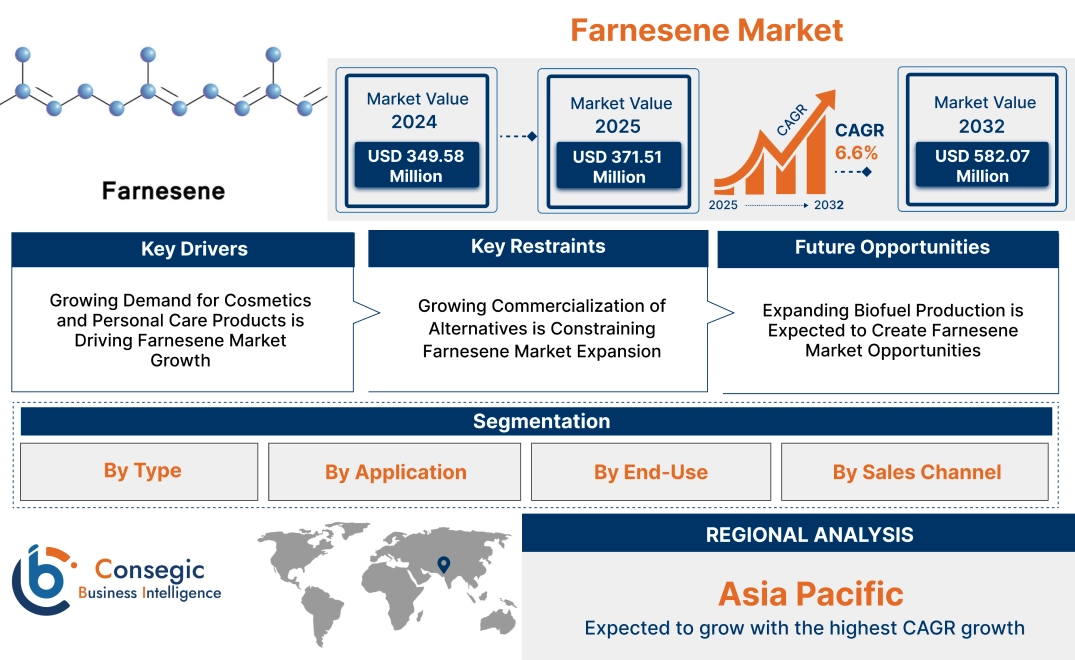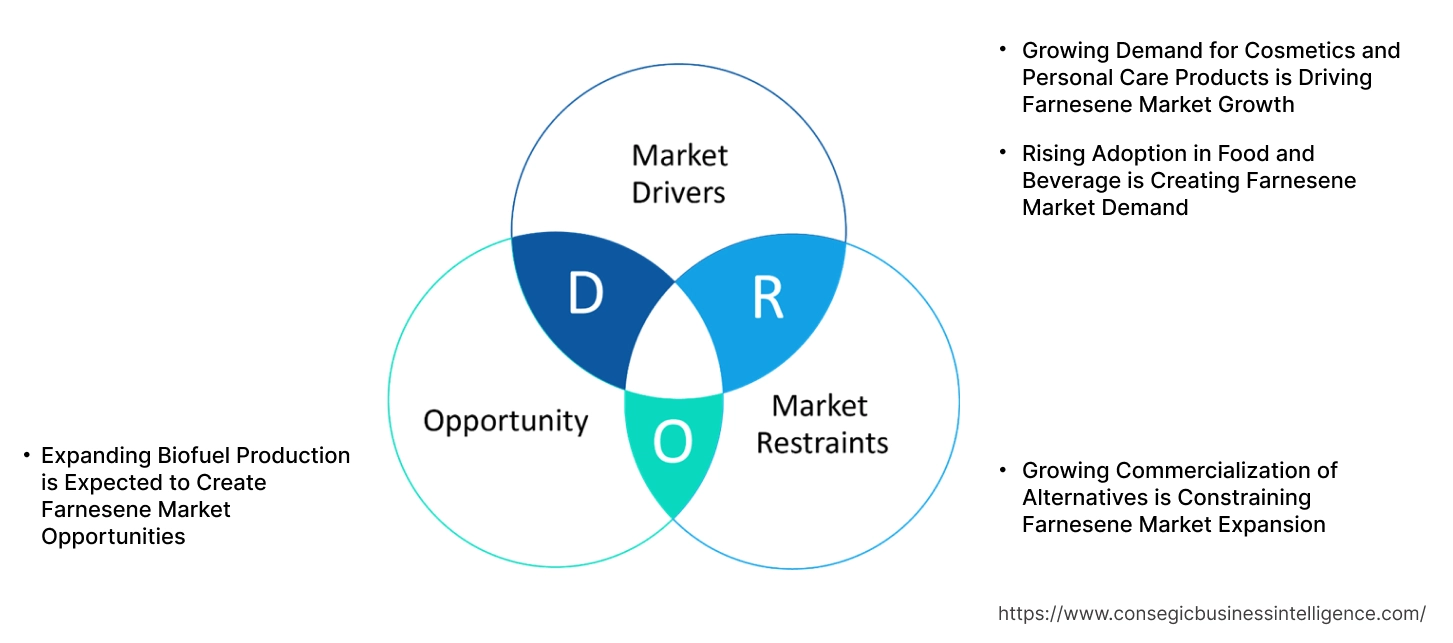- Summary
- Table Of Content
- Methodology
Farnesene Market Size:
The farnesene market size is growing with a CAGR of 6.6% during the forecast period (2025-2032), and the market is projected to be valued at USD 582.07 Million by 2032 from USD 349.58 Million in 2024. Additionally, the market value for the 2025 is attributes to USD 371.51 Million.
Farnesene Market Scope & Overview:
Farnesene is an acyclic sesquiterpene, a naturally occurring compound found in plants and animals with chemical formula C15H24. It appears as an orange crystalline solid with high thermal stability and solubility in organic solvents. It is available in both natural and conventional type. This compound is used in cosmetic formulations, pest management, food processing, biofuel production, and others. In addition to this, it offers several advantages such as anti-inflammation, odor management, and high-energy-density. Due to this, it is used in various sectors such as cosmetics & personal care, agriculture, pharmaceutical, food & beverage, renewable energy, and others. Moreover, this compound is distributed through direct and indirect sales channels to cosmetics manufacturers, food processing units, and pharmaceutical companies.
Key Drivers:
Growing Demand for Cosmetics and Personal Care Products is Driving Farnesene Market Growth
In cosmetics and personal care products, farnesene is used as a softening agent and a solvent, helping other ingredients to dissolve and spread evenly. It is also utilized in fragrance to provide woody, green, and floral odor. Moreover, companies investing in fragrance industry are focusing on the innovation in scent profiles along with the growing interest in personal grooming, furthermore, driving the market.
- In 2024, Unilever invested USD 107 million in fragrance manufacturing. This is leading to more production of fragrance thereby driving the use of farnesene to provide woody, green, and floral odor.
Hence, growing demand for cosmetics and personal care products is leading to farnesene market growth.
Rising Adoption in Food and Beverage is Creating Farnesene Market Demand
In food and beverage production, farnesene is used to enhance to aroma and flavor of cookies, candies, and others. It is also used to add subtle notes of carrot, mango, lime, celery, and parsley to gin and other beverages. Moreover, food and beverage production is growing due to rising global population, changing consumer preferences, and technological advancements, furthermore driving the market.
- According to FoodDrinkEurope, the production of food and beverage is increased by 2.4% in Europe in s2022 as compared to the year 2021. This growing food and beverage production is driving the use of farnesene to enhance to aroma and flavor of food products.
Thus, rising adoption in food and beverage is creating farnesene market demand.
Key Restraints:
Growing Commercialization of Alternatives is Constraining Farnesene Market Expansion
The commercialization of alternative compounds such bisabolene, geraniol amongst others is growing. They provide similar functions to that of farnesene compound. The bisabolene is widely used in cosmetics and personal care products due to its lower production costs and greater availability. Furthermore, geraniol is used as a flavoring agent in food and beverages, contributing to flavors such as apple, strawberry, cinnamon, and ginger. Additionally, ketones such as thujone and pinopamphonedue are used in pharmaceutical products for the treatment of genital and anal warts. Hence, the growing commercialization of alternatives is constraining the market due to low production costs and wide availability.
Future Opportunities:
Expanding Biofuel Production is Expected to Create Farnesene Market Opportunities
Biofuel production is the process of transforming biomass from plants and animals into fuel. Farnesene is produced from renewable sources such as cellulosic sugars through microbial fermentation. It is used in the biofuel production to provide high energy density and low freezing point. Moreover, the production of biofuel is witnessing significant growth due to growing demand, environmental concern, and government support.
- According to International Energy Agency, the biofuel production is expected to increase with a compound annual growth rate of 8% from 2023 to 2028. This growing biofuel production will drive the use of farnesene to provide high energy density.
Hence, expanding biofuel production is expected to create farnesene market opportunities.
Farnesene Market Segmental Analysis :
By Type:
Based on Type, the market is categorized into natural and conventional.
Trends in Type:
- The natural type is extensively used due to low cost, less carbon emission, and abundant availability.
- The adoption of conventional type is growing in lubricants production as per trends.
The natural segment accounted for the largest market share in the year 2024.
- The natural farnesene compound is extracted through apple peel, orange oil, rose oil, and tangerine oil.
- The natural extraction is widely used due to low cost, less carbon emission, and abundant availability.
- This natural compound is used as a building block for creating bio-based thermoplastic elastomosters.
- Furthermore, the adoption of thermoplastic elastomosters is growing due to cost-effectivity, expanding construction projects, and increasing demand for electric cables. To cater this, companies are investing in thermoplastic elastomer.
- For instance, in 2024, GEON Performance Solutions launched thermoplastic elastomer production plant in Mexico. This plant is furthermore facilitating the production of thermoplastic elastomosters, thereby driving the use of natural farnesene compound as a building block.
- Hence, as thermoplastic elastomer production is growing, the need for this compound is also increasing, in turn driving the segment.
The conventional segment is expected to grow at the fastest CAGR over the forecast period.
- The conventional farnesene type is produced through microbial biosynthesis, offering a sustainable and economical alternative to chemical synthesis and natural extraction.
- Yeast such as Saccharomyces cerevisiae and bacteria such as Escherichia coli, are engineered to produce farnesene.
- Metabolic engineering strategies, such as optimizing pathway flux and enzyme expression are also used to produce the conventional type.
- This type has greater efficiency which is used for production of lubricants for high-performance, low-toxicity base oils.
- Furthermore, the use of lubricants is growing due to rising vehicle ownership, industrial proliferation, and the need for improved machinery. To cater this, manufacturers are expanding their lubricant production leading to more use of conventional farnesene compound for high-performance, low-toxicity base oils.
- Thus, as adoption of lubricants is growing, the need for this compound will also increase. This will drive the segment for the forecasted years.
By Application:
Based on Application, the market is categorized into cosmetic formulations, pest management, food processing, biofuel production, and others.
Trends in Application:
- According to farnesene market trends, this compound is widely used in cosmetic formulations an alternative to silicone-free formulating.
- Adoption of farnesene is growing in green jet biofuel due to its low freezing point and low viscosity.
The cosmetic formulations segment accounted for the largest market share in the year 2024.
- In cosmetics formulations, farnesene is used is sun care products for better absorption and dry feel.
- It is also utilized in body washes, cleansers, and creams for foam stability and to enhance texture.
- In addition to this, this compound is also used in makeup removal products as an alternative to silicone-free formulating.
- Furthermore, the adoption of makeup removal is growing due to increased use of makeup, rising disposable income, and proliferation of digital media. To cater this, companies are investing in makeup removal products, thereby driving the use of farnesene compound as an alternative to silicone-free formulating.
- Thus, as production of cosmetics formulations is growing, the need for this compound is also increasing, in turn driving the segment.
The biofuel production segment is expected to grow at the fastest CAGR over the forecast period.
- In biofuel production, the farnesene which has a high cetane number provides better combustion.
- It is particularly used in green jet biofuel due to its low freezing point and low viscosity.
- Furthermore, the adoption of green jet biofuel is growing due to climate change, greenhouse gas emission, and to improve air quality. Due to this, companies are investing in the production of green jet biofuel.
- For instance, in 2024, Avina Clean Hydrogen Inc. invested USD 820 Million in green jet biofuel production. This will lead to more green jet biofuel production, thereby leading to more use of farnesene compound to provide low freezing point.
- Hence, as adoption of green jet biofuel is growing, the need for this compound will also increase. This will drive the segment over the forecasted years.
By End Use:
Based on End-Use, the market is categorized into cosmetics & personal care, agriculture, pharmaceutical, food & beverage, renewable energy, and others.
Trends in End-Use:
- As per farnesene market trends, this compound is extensively used in anti-aging formulations due to anti-oxidant properties.
- Adoption of farnesene is growing in the production of battery energy storage systems to produce dielectric fluids as per trends.
The cosmetics and personal care segment accounted for the largest market share of 35.13% in the year 2024.
- In cosmetics and personal care sector, farnesene is used shampoos, conditioners, and hair serums to enhance in shine, smoothness and frizz control.
- It is also utilized in lip balm and lipsticks for moisture retention and to provide non-greasy texture.
- In addition to this, the compound is also used in anti-aging formulations to reduce wrinkles and fine lines due to antioxidant properties.
- Furthermore, adoption of anti-aging formulations is growing due to continuous product innovation and increasing consciousness about appearance. To cater this, companies are investing in the anti-aging formulations.
- Thus, as production of color cosmetics is growing, the need for this compound is also increasing, in turn driving the segment.
The renewable energy segment is expected to grow at the fastest CAGR over the forecast period.
- In renewable energy sector, farnesene compound is used in the production of high-performance, biodegradable lubricants to reduce friction and energy consumption.
- It is also used to produce dielectric fluids for capacitors in battery energy storage systems.
- Furthermore, the adoption of battery energy storage systems is growing due to increasing need for grid stability and the rise of electric vehicles. To cater this, government authorities are investing in battery energy storage systems.
- In 2024, S. Department of Energy announced investment of USD 289.7 million in Sunwealth Project Polo to expand their manufacturing of battery energy storage systems. This will lead to more production of battery energy storage systems thereby increasing use of farnesene compound to produce dielectric fluids.
- Hence, as adoption of battery energy storage systems is growing, the need for this compound will also increase. This will drive the segment for the forecasted years.
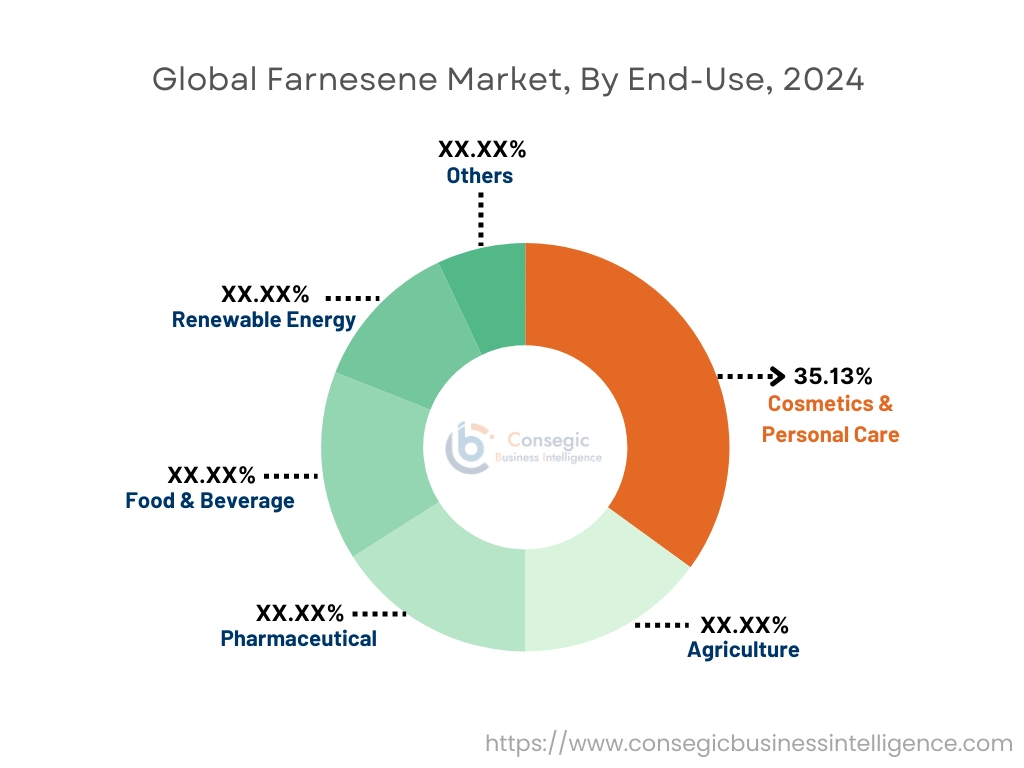
By Sales Channel:
Based on Sales Channel, the market is categorized into direct sales and indirect sales.
Trends in Sales Channel:
- Direct sales channel require low procurement cost and provide and easier collaboration with manufacturers.
- Adoption of indirect sales channel is growing due to proliferation of online marketplaces as per market trends.
The direct sales segment accounted for the largest market share in the year 2024.
- Direct sales is a type of sales channel where products are sold directly to customers without any intermediaries.
- The farnesene compound is widely sold through direct sales to cosmetics manufacturers, food processing units, and pharmaceutical companies. They prefer direct sales due to low procurement cost and easier collaboration with manufacturers.
- Furthermore, direct sales channel allows for tailored product recommendations, direct feedback and enhanced customer service. Due to this, direct sales of this compound is expanding.
- For instance, BASF reported 9% growth in sales of chemicals in 2022 as compared to the year 2021. This includes farnesene compound which is directly sold to cosmetics manufacturers, food processing units, and pharmaceutical companies.
- Hence, as preference for tailored products as per the customers need is increasing, the adoption of direct sales is increasing. This is in turn driving the segment.
The indirect sales segment is expected to grow at the fastest CAGR over the forecast period.
- Indirect sales is a type of sales channel where products are sold through intermediaries such as distributors, retailers or agencies.
- It furthermore includes retail sales and online sales where farnesene compound is sold through retailers or through online marketplaces.
- Moreover, online sales offers advantages such as broader customer reach, easy comparison, and flexible payment options.
- Also, online marketplaces offer niche products as compared to the traditional stores along with customer convenience. This is leading to more online sales of this compound.
- Hence, as adoption of online sales is growing, the indirect sales of this compound will also increase. This will drive the segment for the forecasted years.
Regional Analysis:
The regional segment includes North America, Europe, Asia Pacific, Middle East & Africa, and Latin America.
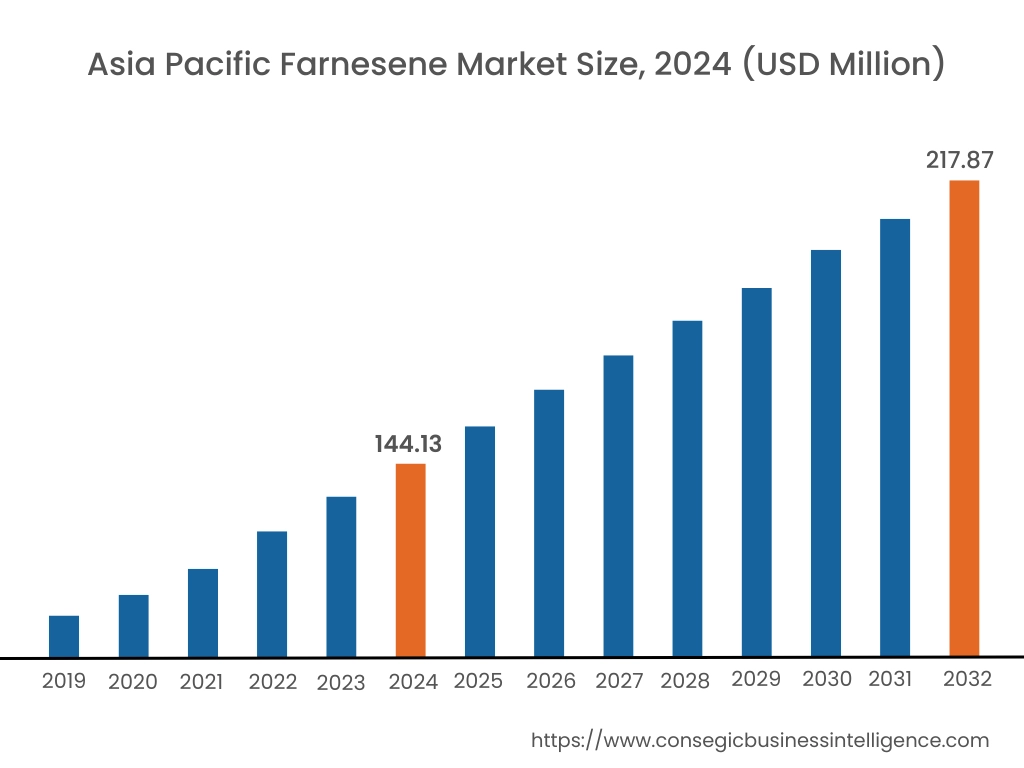
In 2024, Asia Pacific accounted for the highest market share at 41.23% and was valued at USD 144.13 Million and is expected to reach USD 217.87 Million in 2032. In Asia-Pacific, the China accounted for the highest farnesene market share of 38.12% during the base year of 2024. As per analysis, Asia Pacific region holds a dominant position in the market due to expanding cosmetics and personal care sector. In this sector, farnesene compound is used as an emollient, solvent, and texture-enhancing ingredient. It is also utilized in color cosmetics products such as nail paints, lipsticks, and others to achieve even coverage, spreadability and a lightness. Moreover, in the countries such as China, India, Japan, and South Korea, companies are investing in investing in cosmetics manufacturing, furthermore driving the market adoption.
- In 2023, Cosmax Inc. launched cosmetics manufacturing plant in China. This plant is furthermore facilitating the production of cosmetic formulations, thereby driving the use of farnesene compound as an emollient and solvent.
Therefore, due to the above-mentioned factors, the Asia Pacific region is dominating in the market as per analysis.
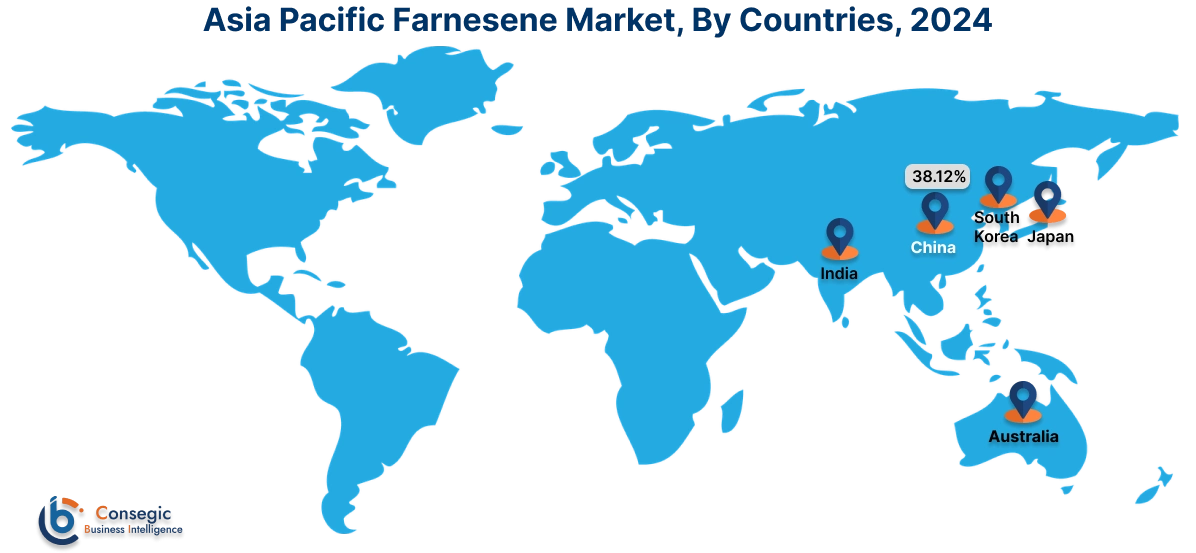
Europe is expected to witness the fastest CAGR of 9% over the forecast period of 2025-2032. According to farnesene market analysis, Europe region is growing considerably in the market driven by agriculture sector. In this sector, farnesene is used for pest control, interfering with aphid feeding and physiological processes. It is also utilized in the plant growth regulator to enhance the crop resistance to drought and temperature fluctuations. Additionally, countries such as Germany, France, and United Kingdom are major contributors in the market due to strong investment in crop production. Hence, farnesene market share of Europe is expected to emerge rapidly through expansion of agriculture sector as per analysis.
According to farnesene market analysis, North America region is growing considerably in the market driven by technological advancements. Advancement in microbial fermentation and chemical synthesis have enhanced the efficiency, sustainability, and cost-effectiveness of compound. Innovations in automation and artificial intelligence driven process control are optimizing production and ensuring high-performance compound for cosmetics and biofuel. This is furthermore fueling the market growth in the region.
The Middle East & Africa region is experiencing moderate growth in the market driven by expanding food and beverage industry. The farnesene is used in yeast metabolism during fermentation in craft beer and wines. It is also utilized in dairy products such as milk to expand their shelf-life. The population in the region are increasingly adopting dairy products, furthermore driving the market adoption.
As per analysis, the market in Latin America is driven by pharmaceutical industry. The farnesene is used as a precursor to vitamin E, a common vitamin product. It is also utilized in pain relievers such as aspirin and ibuprofen due to its anti-inflammatory and antiallergy properties. Additionally, in countries such as Brazil, Argentina, and Columbia, pharmaceutical manufacturing plants are expanding. This is leading to farnesene market expansion across the region.
Top Key Players & Market Share Insights:
The farnesene industry is highly competitive with major players providing products to the national and international markets. Key players are adopting several strategies in research and development (R&D) and product innovation to hold a strong position in the global farnesene market. Key players in the farnesene industry include-
- Precigen Inc. (United States)
- American Enzyme Company (United States)
- Intrexon Corporation (United States)
- Merck KGaA (Germany)
- Kuraray Co., LTD. (Japan)
- LyondellBasell Industries Holdings B.V (United States)
- Braskem S.A. (Brazil)
- Chevron Phillips Chemical Company (United States)
Farnesene Market Report Insights:
| Report Attributes | Report Details |
| Study Timeline | 2019-2032 |
| Market Size in 2032 | USD 582.07 Million |
| CAGR (2025-2032) | 6.6% |
| By Type |
|
| By Application |
|
| By End Use |
|
| By Sales Channel |
|
| By Region |
|
| Key Players |
|
| North America | U.S. Canada Mexico |
| Europe | U.K. Germany France Spain Italy Russia Benelux Rest of Europe |
| APAC | China South Korea Japan India Australia ASEAN Rest of Asia-Pacific |
| Middle East and Africa | GCC Turkey South Africa Rest of MEA |
| LATAM | Brazil Argentina Chile Rest of LATAM |
| Report Coverage |
|
Key Questions Answered in the Report
How big is the farnesene market? +
In 2024, the farnesene market is USD 349.58 Million.
Which is the fastest-growing region in the farnesene market? +
Europe is the fastest-growing region in the farnesene market.
What specific segmentation details are covered in the farnesene market? +
Type, Application, End-Use, and Sales Channel are covered in the farnesene market.
Who are the major players in the farnesene market? +
Amyris (United States), BASF (Germany), and Merck KGaA (Germany) are some of the major players in the market.
